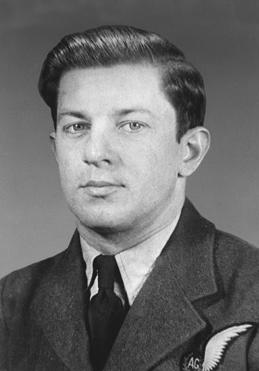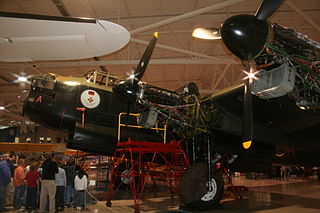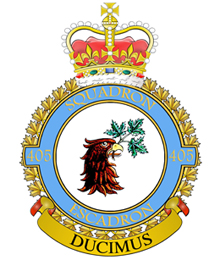
The Avro Lancaster is a British Second World War heavy bomber. It was designed and manufactured by Avro as a contemporary of the Handley Page Halifax, both bombers having been developed to the same specification, as well as the Short Stirling, all three aircraft being four-engined heavy bombers adopted by the Royal Air Force (RAF) during the same era.

The Avro Canada CF-100 Canuck is a Canadian twinjet interceptor/fighter designed and produced by aircraft manufacturer Avro Canada. It has the distinction of being the only Canadian-designed fighter to enter mass production.

Andrew Charles Mynarski, VC was a Canadian airman and a recipient of the Victoria Cross, the highest award for bravery in the face of the enemy that can be awarded to British and Commonwealth forces. Mynarski was 27 years old and flew with No. 419 "Moose" Squadron, Royal Canadian Air Force during the Second World War when he died attempting to help rescue a trapped crew member. His Victoria Cross, which was awarded in 1946, was the last Victoria Cross received by any Canadian serviceman in the Second World War.

Victory Aircraft Limited was a Canadian manufacturing company that, during the Second World War, built mainly British-designed aircraft under licence. It acted as a shadow factory, safe from the reach of German bombers.

Canadian Forces Base Greenwood, or CFB Greenwood, is a Canadian Forces Base located 1.5 nautical miles east of Greenwood, Nova Scotia. It is primarily operated as an air force base by the Royal Canadian Air Force and is one of two bases in the country using the CP-140 Aurora and CP-140A Arcturus anti-submarine/maritime patrol and surveillance aircraft. Its primary RCAF lodger unit is 14 Wing, commonly referred to as 14 Wing Greenwood.

The Battle of Britain Memorial Flight (BBMF) is a Royal Air Force flight which provides an aerial display group usually comprising an Avro Lancaster, a Supermarine Spitfire and a Hawker Hurricane. The aircraft are regularly seen at events commemorating the Second World War and upon British State occasions, notably Trooping the Colour, celebrating Queen Elizabeth II's 80th birthday in 2006, as well as the wedding of Prince William and Catherine Middleton in 2011 and at air displays throughout the United Kingdom and Europe.

Canadian Forces Base Trenton, formerly RCAF Station Trenton, is a Canadian Forces base located within the city of Quinte West, Ontario. It is operated as an air force base by the Royal Canadian Air Force (RCAF) and is the hub for air transport operations in Canada and abroad. Its primary RCAF lodger unit is 8 Wing, commonly referred to as 8 Wing Trenton. CFB Trenton is Canada's largest Air Force base and most southerly air base.

RAF Middleton St George is a former Royal Air Force (RAF) and Royal Canadian Air Force (RCAF) Bomber Command station during the Second World War. It was located in County Durham, 6 mi (9.7 km) east of Darlington, England. The station's motto was Shield and Deter. The aerodrome remains active as Teesside International Airport.

The Canadian Warplane Heritage Museum is an aviation museum located at the John C. Munro Hamilton International Airport in Mount Hope, Ontario, Canada. The museum has 47 military jets and propeller-driven aircraft on display.

408 Tactical Helicopter Squadron is a unit of 1 Wing, Kingston. It is co-located with 1 Canadian Mechanized Brigade Group at Canadian Forces Base (CFB) Edmonton.

No. 420 "City of London" Squadron RCAF was a squadron of the Royal Canadian Air Force (RCAF) which existed from late December 1941 forwards. The Squadron's nickname was "Snowy Owl". Their motto was Pugnamus Finitum, Latin for We Fight To The Finish. No. 420 Squadron is no longer active.

419 Tactical Fighter Training Squadron is a unit of the Royal Canadian Air Force. The squadron was originally formed during the Second World War and is currently based at CFB Cold Lake. It is responsible for advanced tactical fighter training for pilots of the RCAF and as part of the NATO Flying Training in Canada (NFTC) program using nine CT-155 Hawk trainers.
Canadian Associated Aircraft was a joint Canadian-United Kingdom project to build Handley Page Hampden aircraft in the late 1930s.

400 "City of Toronto" Tactical Helicopter and Training Squadron is part of 1 Wing, and as such a lodger unit of Canadian Forces Base Borden. The squadron operates the CH-146 Griffon.

No. 428 Squadron RCAF, also known as 428 Bomber Squadron, and 428 Ghost Squadron, was first a night bomber squadron of the Royal Canadian Air Force engaged in strategic bombing during World War II, based in Yorkshire. At the end of the war the squadron moved to Nova Scotia before being disbanded in September 1945. In 1954 the squadron was reformed as 428 All-Weather (Fighter) Squadron, before being again disbanded in 1961.

405 Long Range Patrol Squadron is a unit of the Royal Canadian Air Force (RCAF) within the Canadian Forces, initially formed as No. 405 Squadron RCAF during the Second World War.

Avro Lancaster PA474 is a four-engined, Second World War era, Avro Lancaster heavy bomber operated by the Royal Air Force Battle of Britain Memorial Flight as a tribute to all members of Bomber Command during the Second World War.

The Canadian Air and Space Conservancy was an aviation museum that was located in Toronto, Ontario, featuring artifacts, exhibits and stories illustrating a century of Canadian aviation heritage and achievements. The museum was located in a hangar that once housed the original de Havilland Canada aircraft manufacturing building, but in September 2011 the museum and all of the other tenants in the building were evicted by the landlord, the Crown Corporation, PDP. The site was slated for redevelopment as a new sports centre but after closing the museum the development was placed on hold. The museum is developing a new location and its collections are currently not available for public viewing.
No. 1 General Reconnaissance School RCAF was a flight training unit in 3 Training Command, of the Royal Canadian Air Force, flying Avro Ansons from RCAF Station Summerside, PEI.



















